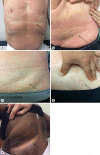The Importance of Excluding Cutaneous T-Cell Lymphomas in Patients with a Working Diagnosis of Papuloerythroderma of Ofuji: A Case Series
- PMID: 29606946
- PMCID: PMC5869582
- DOI: 10.1159/000487473
The Importance of Excluding Cutaneous T-Cell Lymphomas in Patients with a Working Diagnosis of Papuloerythroderma of Ofuji: A Case Series
Abstract
Papuloerythroderma of Ofuji (PEO) is an erythroderma-like eruption with flat-topped papules that spare the skin folds (a "deck-chair sign" finding). Many infections, medications, and systemic diseases have been associated with PEO, including cutaneous T-cell lymphomas (CTCL). The relationship between the clinical presentation of PEO and CTCL remains poorly elucidated. Clinical, laboratory, and histopathological data were obtained from the Lymphoma Clinic at the Ottawa Hospital, Canada. We report 5 patients with deck-chair-sign-positive CTCL, mycosis fungoides, and Sézary syndrome variants. We contend that PEO should be viewed as a diagnosis of exclusion and that these patients should be monitored carefully for possible emergence of CTCL. Skin biopsy alone is not sufficient to exclude CTCL in these patients. A skin eruption demonstrating a positive deck-chair sign may signify systemic/leukemic CTCL and, therefore, warrants a thorough investigation, including skin biopsy, flow cytometry, and T-cell receptor clonality studies.
Keywords: Cutaneous T-cell lymphomas; Deck-chair sign; Erythroderma; Mycosis fungoides; Papuloerythroderma of Ofuji; Sézary syndrome.
Figures
References
-
- Ofuji S, Furukawa F, Miyachi Y, Ohno S. Papuloerythroderma. Dermatologica. 1984;169:125–130. - PubMed
-
- Farthing CF, Staughton RC, Harper JI, Rowland Payne CM, Copeman PW. Papuloerythroderma - a further case with the ‘deck chair sign’. Dermatologica. 1986;172:65–66. - PubMed
-
- Bech-Thomsen N, Thomsen K. Ofuji's papuloerythroderma: a study of 17 cases. Clin Exp Dermatol. 1998;23:79–83. - PubMed
-
- Olsen EA, Whittaker S, Kim YH, et al. Clinical end points and response criteria in mycosis fungoides and Sezary syndrome: a consensus statement of the International Society for Cutaneous Lymphomas, the United States Cutaneous Lymphoma Consortium, and the Cutaneous Lymphoma Task Force of the European Organisation for Research and Treatment of Cancer. J Clin Oncol. 2011;29:2598–2607. - PMC - PubMed
-
- Torchia D, Miteva M, Hu S, Cohen C, Romanelli P. Papuloerythroderma 2009: two new cases and systematic review of the worldwide literature 25 years after its identification by Ofuji et al. Dermatology. 2010;220:311–320. - PubMed
Publication types
LinkOut - more resources
Full Text Sources
Other Literature Sources


